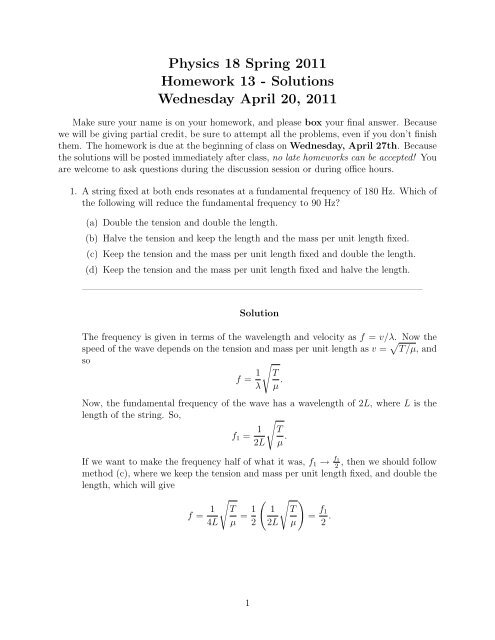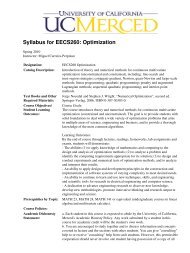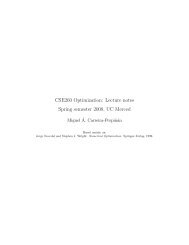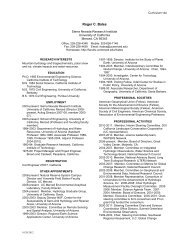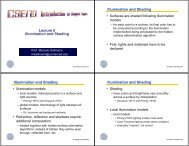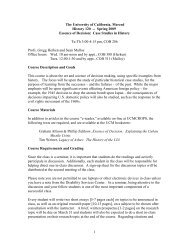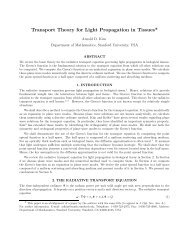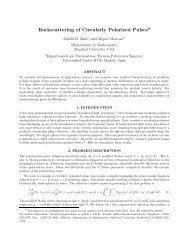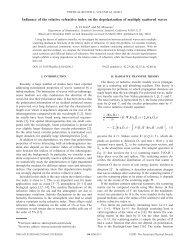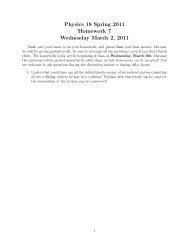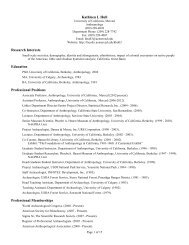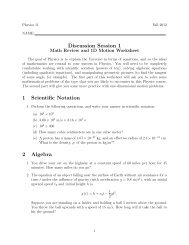Physics 18 Spring 2011 Homework 13 - Solutions Wednesday April ...
Physics 18 Spring 2011 Homework 13 - Solutions Wednesday April ...
Physics 18 Spring 2011 Homework 13 - Solutions Wednesday April ...
Create successful ePaper yourself
Turn your PDF publications into a flip-book with our unique Google optimized e-Paper software.
<strong>Physics</strong> <strong>18</strong> <strong>Spring</strong> <strong>2011</strong><br />
<strong>Homework</strong> <strong>13</strong> - <strong>Solutions</strong><br />
<strong>Wednesday</strong> <strong>April</strong> 20, <strong>2011</strong><br />
Make sure your name is on your homework, and please box your final answer. Because<br />
we will be giving partial credit, be sure to attempt all the problems, even if you don’t finish<br />
them. The homework is due at the beginning of class on <strong>Wednesday</strong>, <strong>April</strong> 27th. Because<br />
the solutions will be posted immediately after class, no late homeworks can be accepted! You<br />
are welcome to ask questions during the discussion session or during office hours.<br />
1. A string fixed at both ends resonates at a fundamental frequency of <strong>18</strong>0 Hz. Which of<br />
the following will reduce the fundamental frequency to 90 Hz?<br />
(a) Double the tension and double the length.<br />
(b) Halve the tension and keep the length and the mass per unit length fixed.<br />
(c) Keep the tension and the mass per unit length fixed and double the length.<br />
(d) Keep the tension and the mass per unit length fixed and halve the length.<br />
————————————————————————————————————<br />
Solution<br />
The frequency is given in terms of the wavelength and velocity as f = v/λ. Now the<br />
speed of the wave depends on the tension and mass per unit length as v = T/µ, and<br />
so<br />
f = 1<br />
<br />
λ<br />
T<br />
µ .<br />
Now, the fundamental frequency of the wave has a wavelength of 2L, where L is the<br />
length of the string. So,<br />
f1 = 1<br />
<br />
2L<br />
T<br />
µ .<br />
If we want to make the frequency half of what it was, f1 → f1 , then we should follow<br />
2<br />
method (c), where we keep the tension and mass per unit length fixed, and double the<br />
length, which will give<br />
f = 1<br />
<br />
4L<br />
T<br />
µ = 1<br />
<br />
2<br />
1<br />
2L<br />
T<br />
µ<br />
= f1<br />
2 .<br />
1
2. Estimate the resonant frequencies that are in the audible range of human hearing of<br />
the human ear canal. Treat the canal as an air column open at one end, stopped at<br />
the other end, and with a length of 1.00 in. How many resonant frequencies lie in<br />
this range? Human hearing has been found experimentally to be the most sensitive<br />
at frequencies of about 3, 9, and 15 kHz. How do these frequencies compare to your<br />
calculations?<br />
————————————————————————————————————<br />
Solution<br />
The ear is an open-closed tube, and so has allowed standing-wave frequencies of fn =<br />
v<br />
4Ln = f1n, where n = 1, 3, 5, · · · , and f1 = v 343 = = 3376 Hz, or 3.376 kHz, is<br />
4L 4×0.0254<br />
the fundamental frequency (we have recalled that one inch is 2.54 centimeters. The<br />
next few frequencies are<br />
f3 = 3f1 = 3(3.376) = 10.<strong>13</strong> kHz<br />
f5 = 5f1 = 5(3.376) = 16.9 kHz<br />
f7 = 7f1 = 7(3.376) = 23.6 kHz.<br />
Now, the high-end of audible frequencies for the human ear is about 20 kHz, so the<br />
n = 7 mode isn’t within range. So, there are only three resonant modes, n = 1, 3, 5,<br />
and the theoretical values are fairly close to the experimental values.<br />
2
3. It is thought that the brain determines the direction of the source of a sound by sensing<br />
the phase difference between the sound waves striking the eardrums. A distance source<br />
emits sound of frequency 680 Hz. When you are directly facing a sound source there<br />
is no phase difference. Estimate the phase difference between the sounds received by<br />
your ears when you are facing 90 ◦ away from the direction of the source.<br />
————————————————————————————————————<br />
Solution<br />
The phase difference is just due to the extra distance that one wave travels over another,<br />
δ = 2π∆x.<br />
We can rewrite this in terms of the speed and frequency of the wave, v = λf,<br />
λ<br />
giving<br />
δ = 2π<br />
v ∆xf.<br />
Suppose that there is a distance of about 20 centimeters between your ears. Then,<br />
since the speed of sound is 343 m/s, we have<br />
δ = 2πf ∆x<br />
v<br />
= 2π (680) .2<br />
343<br />
3<br />
= 2.49 rad.
4. A standing wave on a rope is represented by the wave function<br />
<br />
1<br />
y(x, t) = (0.020) sin<br />
2 πx<br />
<br />
cos(40πt),<br />
where x and y are in meters, and t is in seconds.<br />
(a) Write wave functions for two traveling waves that, when superimposed, produce<br />
this standing-wave pattern.<br />
(b) What is the distance between the nodes of the standing wave?<br />
(c) What is the maximum speed of the rope at x = 1.0 m?<br />
(d) What is the maximum acceleration of the rope at x = 1.0 m?<br />
————————————————————————————————————<br />
Solution<br />
(a) Recall that the sum of two sine waves is<br />
<br />
1<br />
1<br />
sin A + sin B = 2 cos (A − B) sin (A + B) .<br />
2 2<br />
This is precisely the correct form of the given standing wave, so we can write<br />
<br />
π<br />
<br />
π<br />
<br />
y (x, t) = 0.010 sin x − 40πt + 0.010 sin x + 40πt ,<br />
2 2<br />
which gives the superposition of a wave traveling to the right and another traveling<br />
to the left.<br />
(b) The distance between the nodes is just half the wavelength. Now, the wave vector<br />
k = 2π/λ = π/2, so λ = 4 meters, and thus the distance between the nodes is<br />
d = 2 meters.<br />
(c) The speed of the rope (not the wave) is just the derivative of the displacement,<br />
v = ˙y. Taking the derivative gives<br />
v = d<br />
dt<br />
(0.020) sin 1<br />
2 πx cos(40πt) <br />
= (0.020) sin 1<br />
2 πx d<br />
dt [cos(40πt)]<br />
= −(0.800)π sin 1<br />
2 πx sin(40πt).<br />
Now, the maximum speed occurs when the cosine is −1 (to cancel the minus sign<br />
in the velocity). So, the maximum velocity is v = 0.8π sin π<br />
2 x . When x = 1,<br />
then<br />
<br />
π<br />
<br />
v (x = 1) = 0.8π sin = 0.8π m/s = 2.5 m/s.<br />
2<br />
(d) The acceleration is just the second derivative of the position, a = ¨y, or<br />
a = d2<br />
dt 2<br />
(0.020) sin 1<br />
2 πx cos(40πt) <br />
= (0.020) sin 1<br />
2πx d2 dt2 [cos(40πt)]<br />
= −32π2 sin 1<br />
2πx sin(40πt).<br />
Again, the maximum acceleration occurs when the cosine is −1, and when x = 1,<br />
we find amax = 32π2 m/s2 .<br />
4
5. Ultrasound has many medical applications, one of which is to monitor fetal heartbeats<br />
by reflecting ultrasound off a fetus in the womb.<br />
(a) Consider an object moving at speed v0 toward an at-rest source that is emitting<br />
sound waves of frequency f0. Show that the reflected wave (i.e., the echo) that<br />
returns to the source has a Doppler-shifted frequency<br />
<br />
v + v0<br />
fecho = f0,<br />
v − v0<br />
where v is the speed of sound in the medium.<br />
(b) Suppose that the object’s speed is much less than the wave speed: v0 ≪ v. then<br />
fecho ≈ f0, and a microphone that is sensitive to these frequencies will detect<br />
a beat frequency if it listens to f0 and fecho simultaneously. Use the binomial<br />
expansion and other appropriate approximations to show that the beat frequency<br />
is fbeat ≈ 2v0<br />
v f0.<br />
(c) The reflection of 2.40 MHz ultrasound waves from the surface of a fetus’s beating<br />
heart is combined with the 2.40 MHz wave to produce a beat frequency that<br />
reaches a maximum of 65 Hz. What is the maximum speed of the surface of the<br />
heart? The speed of ultrasound waves within the body is 1540 m/s.<br />
(d) Suppose the surface of the heart moves in simple harmonic motion at 90 beats/min.<br />
What is the amplitude in mm of the heartbeat?<br />
————————————————————————————————————<br />
Solution<br />
(a) The source is at rest and is sending out the waves, which leads to a (higher)<br />
Doppler-shifted frequency received by the object, fR = f0 (1 + v0/v). This frequency<br />
is reflected back to the source, but the object now looks like a moving<br />
source, and the frequency is Doppler-shifted for a second time, fecho = fR<br />
1−v0/v .<br />
Plugging in for fR from before gives<br />
<br />
1 + v0/v v + v0<br />
fecho =<br />
f0 = f0,<br />
1 − v0/v v − v0<br />
as claimed.<br />
(b) The beat frequency is just the difference between the echo frequency and the<br />
originalo frequency, fecho − f0. Now, recalling that v0 ≪ v, then, recalling that<br />
(1 + ɛ) α ≈ 1 + αɛ, for small ɛ,<br />
<br />
1+v0/v<br />
fecho =<br />
1−v0/v<br />
1 − v0<br />
= 1 + v0<br />
v<br />
≈ 1 + v0<br />
<br />
v0<br />
<br />
1 + v <br />
2v0<br />
≈ 1 + f0,<br />
5<br />
v<br />
f0<br />
−1 f0 v <br />
f0 v
where we have dropped terms of order (v0/v) 2 and higher. Thus,<br />
<br />
fbeat ≈ fecho − f0 = 1 + 2v0<br />
<br />
f0 − f0 =<br />
v<br />
2v0<br />
v f0.<br />
(c) Here we just plug in the numbers to find v0 using our results from part (b),<br />
or about 2.1 cm/s.<br />
v0 = fbeat<br />
v =<br />
2f0<br />
65<br />
× 1540 = 0.0209 m/s,<br />
2 × 2.40 × 106 (d) The amplitude, A, is given in terms of the maximum velocity as vmax = v0 = ωA,<br />
where ω = 2πf is the angular frequency. So,<br />
which is about 2.2 mm.<br />
A = v0<br />
2πf<br />
= 0.0209<br />
2π (90/60)<br />
6<br />
= 0.0022 m,


